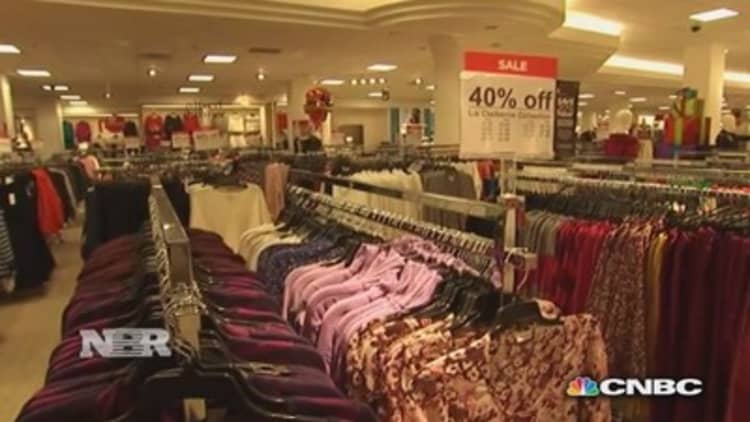For some brands, the mall of the future already has arrived.
Affordable luxury label Kate Spade earlier this week unveiled shoppable scaffolding in New Jersey's Short Hills mall, which makes it possible for consumers to interact with and purchase items from the brand before the store even opens.
By taking a short personality quiz that's spread out across four touch screens—the results of which can be shared on social media—the shoppable construction barricades also make it possible for the brand to gain insight into shoppers' preferences in a particular region. In addition, they provide the company with contact information for potential customers.
Read MoreSay hello to the future mall: It's nothing like today
The digital storefronts were created in partnership with The Science Project, a firm that brings digital innovations to physical stores, and has created interactive holiday windows for Barneys New York and Saks.
"We are always looking to find solutions to improve our overall customer experience," said Mary Beech, chief marketing officer at Kate Spade. "Often … that solution is something digital, something interactive."

Beech said the brand approached the project, which started construction in early September, as a way to start a conversation with shoppers before its store opens later this month. In the past, she said, although Kate Spade used signage to introduce the brand before it cut the ribbon on a new location, "it was very much a one-way message."
Now, shoppers answer four short questions (for example, what is your ideal dinner party?), and then enter their email address or phone number. Seconds later, they receive their personal style statement on their mobile device, along with a curated list of eight items that fit their profile.
Shoppers can then click through to visit the Kate Spade website and purchase the items, which are sent out through free one-day shipping.
Read MoreHigh stakes as runway fashion goes mainstream
Beech said even if consumers drop off before they enter their contact information or make a purchase—something she expects will inevitably happen—the brand's return on investment doesn't just come from these pieces. Instead, it also comes via education.
For instance, the kiosk at the Short Hills mall may find that women in New Jersey prefer to wear a lot of sparkle; at a future location, it may find users don't like to dress as flashy. This can help the brand better stock its stores with items that will resonate with shoppers in a particular area, said Jeremy Bergstein, founder of The Science Project.
"They get to really collect that localized data and it can help them do things more efficiently and understand customers better," Bergstein said.
The brand will open a second shoppable barricade at a yet to be disclosed location in November, which will be put in place about a month prior to the store's opening. From there, Beech said the company will look for more opportunities in 2015, though no specific rollout plan has been put in place.
Kate Spade is known for being an industry leader when it comes to digital and is one of a handful of fashion brands that earned a "genius" ranking from think tank L2.
Last year, the label partnered with eBay on a series of 24-hour window shops that allowed consumers to shop its secondary Saturday line from the streets of New York, without opening a physical store location. Although Beech could not comment on the sales or number of users that interacted with the windows, she said they "did what we needed to do" to launch the brand in North America.
Read MoreWhat's hot and what's not in fashion stocks
Both projects are examples of what Bergstein referred to as "square footage scenarios that are now becoming the new norm."
"I think the malls have to be much more playful and experiential, and they have to optimize every square foot," Bergstein said.
Still, despite these innovations—and the fact that some analysts have said the flirty, feminine label has the potential to unseat Michael Kors as the next hot brand—Spade's shares have struggled in recent months.
After the brand's second-quarter earnings report in August—when it posted a 30 percent comparable sales gain and beat consensus earnings estimates, but warned it was facing promotional pressures—the stock has fallen to trade near $27. It touched as high as $42.87 this year, after investors viewed its initial results Aug. 12.


